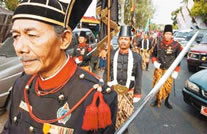ACEH PROVINCE

Overview
Aceh is the northernmost province on Sumatra and in Indonesia, the provincial capital is Banda Aceh with a population of approx. 150.000. The province is rich on resources, mainly oil and natural gas. The most important agricultural products are rice, coconuts, rubber, tea and coffee. Aceh has because of it's location always been one the first points of contact with foreigners, with both positive and negative consequences. Indian, European and Arabic visitors have all had great influence through the spreading of religion and culture and also occupation. The location by the Malacca strait has also for periods led to intensive trade and high economic growth. Buddhism came to Aceh with Indian traders in the 7th century, while Islam was introduced by Arabic and Indian Muslims in the 13th century. Aceh is today considered as the province in Indonesia where Islam has the strongest position. It is run under Islamic law. However, the Achenese also embrace animism, and offerings and rituals continue to play an important part in their lives.
 ..
.. ..
..
History
The years from 1604 to 1637 under the rule of sultan Iskandar Muda became a golden age for Aceh, and the region grew to include parts of the Malaysian peninsula and eastern Sumatra. Their independence became a big problem for the Dutch, who declared war in 1873 (the Aceh war 1873-1878). With a military force of 10.000 men they finally conquered Banda Aceh, but the Dutch suffered great losses. In a guerilla war that lasted until 1903 they lost thousands of men. The Dutch occupants however never felt safe for sabotage actions as long as they stayed in the province. The arrival of the Japanese in 1942 was first saluted, but the sentiments quickly changed when the Acehnese never met any respect from the new occupants.
In 1951 Aceh was merged with North Sumatra with the local government placed in Medan. To find themselves together with the Christian Batak people were not applauded, and the leader of the Islamic Party, Daud Beureueh, declared Aceh as an independent Islamic Republic in 1953. The standoff were partially solved in 1961 when the central government granted Aceh it's own provincial status with more autonomy. During his rule president Suharto controlled the province with thousands of soldiers, but lately a strong freedom movement has again grown to a point where Aceh again is fighting for independence. It is said, maybe rightly so, that Jakarta is emptying the province of it's large natural resources, without giving much in return to Aceh's own population. A resurgence of violence since April 1999, was lead by the Free Aceh Movement. In December 2002 an internationally brokered peace deal was signed by both sides, but deep hostility remained. In mid-May 2003 peace talks broke down and martial law was imposed in Aceh. A fullscale military assault followed with death and destruction widespread. The election in September 2004 of President Susilo Bambang Yudoyono is unlikely to herald a change of government tactics. The former general is as committed to the preservation of Indonesia's territorial integrity as his predecessors.
The Aceh population are a mix of native Acehnese, Indonesians, Arabs, Indians, Chinese, Gayo and several groups of indigenous people. The art and craftsmanship traditions are therefore strong and varied, examples of what is produced are gold and silver wear of good quality, woven textiles and embroided textiles. The music are often played on a three stringed instrument called "arbab" and bamboo flutes.


City of Banda Aceh
The provincial capital of Banda Aceh is clearly the largest and most lively city in the region. The first part of its name comes from the Persian bandar and means "port" or "haven". The city has a mix of old and grandiose architecture from the golden days and more modern buildings. The maybe most famous landmark here is the Mesjid Raya Baiturrahman mosque in the southern part of the city, behind the mosque is a large market. Most of the hotels and restaurants are located in the northern part. North of Banda Aceh is the beautiful Pulau Weh island, many come to Aceh just to visit this island with it's lovely beaches and good diving conditions.
There are three significant inlets at Banda Aceh that are actively used as fishing ports and for navigation. In addition, there is a new inter-island harbour, which is used to travel from Banda Aceh to Sabang Island and is expected to become a very active harbour since Sabang Island has become a free-port. However, dramatic shoreline changes occur near these inlets. The inlets are largely influenced by tides and serious problems exist related to sedimentation in the inlets and the new inter-island harbour. On the other hand beaches are eroding which may have negative effects on the tourist industry of the region.
[Topography Maps of Banda Aceh]
[Satellite Photos of Banda Aceh]

